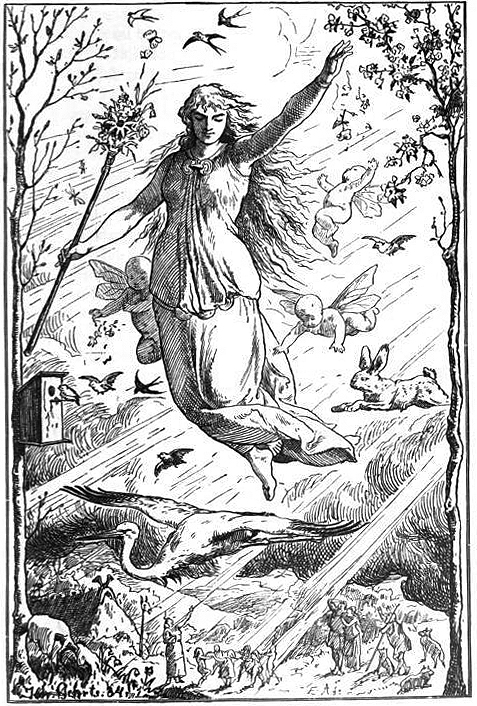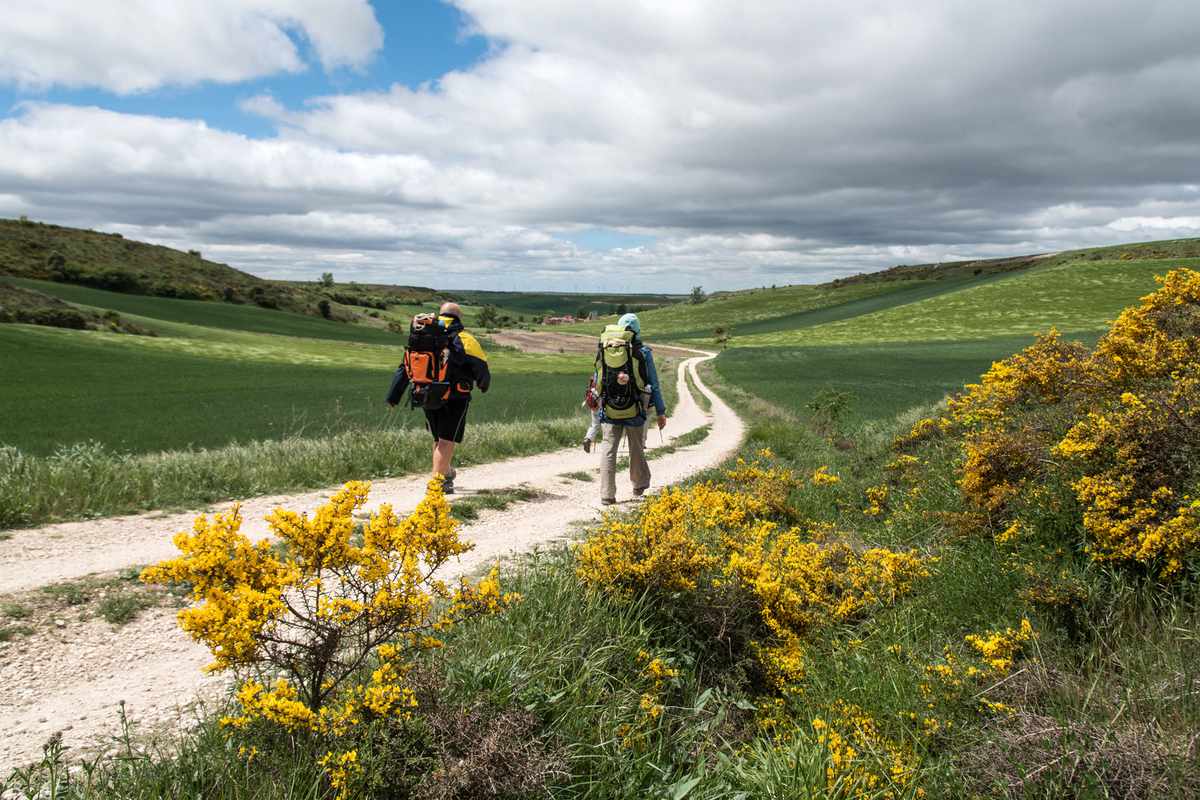* * * *

* * * *
It’s that time of year again. After 46 days of Lent – 40 days mirroring the ones Jesus spent in the Wilderness, plus six Sundays “off*” – it’s time to celebrate another Happy Easter. But you may wonder, “Where and when did all this start?” In the biggest sense of course it all started with Jesus being raised from the dead after being crucified. But the name “Easter” itself has more worldly origins. And it all had to do with how good early Christians were at adapting to the circumstances around them. In other words, applying the Bible with an open mind.
In further words, how did we get from Jesus and His resurrection to the “Easter Bunny, colorfully decorated Easter eggs, and Easter egg hunts?” It seems to have started around 1682:
The Easter Bunny (also called the Easter Rabbit or Easter Hare) is a symbol of Easter, depicted as a rabbit bringing Easter eggs. Originating among German Lutherans, the “Easter Hare” originally played the role of a judge, evaluating whether children were good or disobedient… In legend, [he] carries colored eggs in his basket, candy, and sometimes also toys to the homes of children, and as such shows similarities to Santa Claus or the Christkind, as they both bring gifts to children on the night before their respective holidays.
Then there’s the name “Easter” itself, which comes from Ēostre (or Eastre, or Ostara). She’s the pagan goddess of spring, celebrated by the Saxons of Northern Europe. They held a festival to honor her called Eastre during the spring equinox. Her “earthly symbol was the rabbit, which was also known as a symbol of fertility.” But unfortunately – as one site noted – Easter today has become “almost a completely commercialized holiday, with all the focus on Easter eggs and the Easter bunny being remnants of the goddess worship.” But that’s where we devout practicing Christians come in. To remind people of the real “reason for the season.”
Which brings us back to Jesus, and Easter Sunday. That’s the day we celebrate His resurrection from the dead, “described in the New Testament as having occurred on the third day of his burial after his crucifixion,” at Calvary, around 30 AD. “It is the culmination of the Passion of Jesus, preceded by Lent (or Great Lent), a forty-day period of fasting, prayer, and penance.”
In other words it’s one of many alternating rhythms of “feasting and fasting” in the church year. All of which reminds us that “life is not all fun and games.” In further words, to have a mountaintop experience you have to climb the mountain. (Then once it’s over you have to climb back down again, to the slings and arrows of everyday life. That’s how you make spiritual progress, it seems to me.) In this case, the Disciples and other followers of Jesus had seen all their hopes dashed. They’d believed in Him, yet He ended up in a painful and humiliating death.
But in this case, Jesus “kicked death’s butt,” which was of course hard to believe at first, as shown by Rembrandt‘s painting, “The Risen Christ Appearing to Mary Magdalen.”
Mary Magdalen had just found Jesus’ grave empty, and asks a bystander what has happened. In her confusion she thinks the man is a gardener. Only when he replies with “Mary!” does she realize who she’s talking to. To illustrate Mary’s confusion, Jesus is often depicted as a gardener in this scene.
(Which you can check on your own, as illustrating Mark 16:1-8 and other Gospel accounts.)
And to support the claim that Jesus “kicked death’s butt,” see El Greco‘s painting – just below – of The Resurrection. It shows the Risen Jesus “in a blaze of glory … holding the white banner of victory over death.” In plain words, those of us who believe celebrate this day not because of Easter eggs or chocolate bunnies. We celebrate because by His sacrifice Jesus gave us all the power to become children of God. And that ain’t exactly chopped liver…
* * * *

* * * *
The upper image is courtesy of Ēostre – Wikipedia. The caption: “Ostara (1884) by Johannes Gehrts. The goddess flies through the heavens surrounded by Roman-inspired putti, beams of light, and animals. Germanic people look up at the goddess from the realm below.”
The Book of Common Prayer reference: The “corporate-mystical” prayer is on page 339, the post-communion prayer for Holy Eucharist, Rite I.
For this post I borrowed: From 2015 (mostly), On Easter Season – AND BEYOND. Also, from 2016, On Eastertide – and “artistic license.” From 2017, Frohliche Ostern – “Happy Easter!” From 2019, On Easter, Doubting Thomas Sunday – and a Metaphor. And finally, Happy Easter – April 2020!
Re: Jesus and the 40 days. Known as the Temptation of Christ: During His 40 days and nights of fasting in the Judaean Desert, Satan came and tried to tempt Him. When Jesus “refused each temptation, Satan then departed… During this entire time of spiritual battle, Jesus was fasting.” Wikipedia.
Re: Days off during Lent. See 40 Days and 40 Nights [film] – Wikipedia, the 2002 film about “a San Francisco web designer who has chosen to abstain from any sexual contact for the duration of Lent.” As noted below, he could have had sex by virtue of the “Sundays off” aspect of Lent. See Why Sundays Don’t Count During Lent | Guideposts.
Re: The Rembrandt painting. The full link is “The Risen Christ Appearing to Mary Magdalen” – Art and the Bible. See also Rembrandt – Wikipedia, and/or Rembrandt van Rijn: Life and Work.
Re: “Those of us who believe.” The citation is to 1st Corinthians 1:18, that the “message of the cross is foolishness to those who are perishing, but to us who are being saved it is the power of God.”
The lower image is courtesy of “The Resurrection by El Greco,” and the Web Gallery of Art:
Christ is shown in a blaze of glory, striding through the air and holding the white banner of victory over death. The soldiers who had been placed at the tomb to guard it scatter convulsively. Two of them cover their eyes, shielding themselves from the radiance, and two others raise one hand in a gesture of acknowledgement of the supernatural importance of the event… By excluding any visual reference to the tomb or to landscape, El Greco … articulated its universal significance through the dynamism of nine figures that make up the composition [in] one of the greatest interpretations of the subject in art.
See also Resurrection, 1584-94 by El Greco, and El Greco’s Resurrection: Ahead of its Time: “El Greco considered spiritual expression to be more important than public opinion and it was in this way that he developed a unique style … as one of the great geniuses of Western art.”
* * * *



